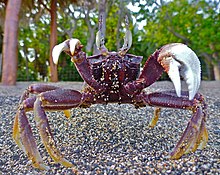Ocypode
| Ocypode | |
|---|---|
 |
|
| Horned ghost crab (Ocypode ceratophthalma) from Kona, Hawaii | |
| Scientific classification | |
| Kingdom: | Animalia |
| Phylum: | Arthropoda |
| Subphylum: | Crustacea |
| Class: | Malacostraca |
| Order: | Decapoda |
| Infraorder: | Brachyura |
| Family: | Ocypodidae |
| Subfamily: | Ocypodinae |
| Genus: |
Ocypode Weber, 1795 |
| Type species | |
|
Cancer ceratophthalmus Pallas, 1772 |
|
| Species | |
|
See text |
|
| Synonyms | |
|
|
See text
Ocypode is a genus of ghost crabs found in the sandy shores of tropical and subtropical regions throughout the world. They have a box-like body, thick and elongated eyestalks, and one claw is larger than the other in both males and females. They inhabit deep burrows in the intertidal zone. They are primarily nocturnal, and are generalist scavengers and predators of small animals. The genus contains 21 species.
The genus Ocypode was first established by the German entomologist Friedrich Weber in 1795, using the type species Cancer ceratophthalmus described by the German naturalist Peter Simon Pallas in 1772. The generic name is derived from the Greek roots ocy- ("fast") and (podos, "foot"), in reference to the animal's speed.
Ocypode was previously the only genus classified under the ghost crab subfamily Ocypodinae until 2013, when Katsushi Sakai and Michael Türkay reclassified the gulf ghost crab into a separate genus, Hoplocypode. It belongs to the family Ocypodidae. Ghost crabs of the genus Hoplocypode can be distinguished from those in Ocypode by examining their gonopods. In the former, the first gonopod has a complex hoof-shaped tip, while in the latter they are simple and curved.
...
Wikipedia
